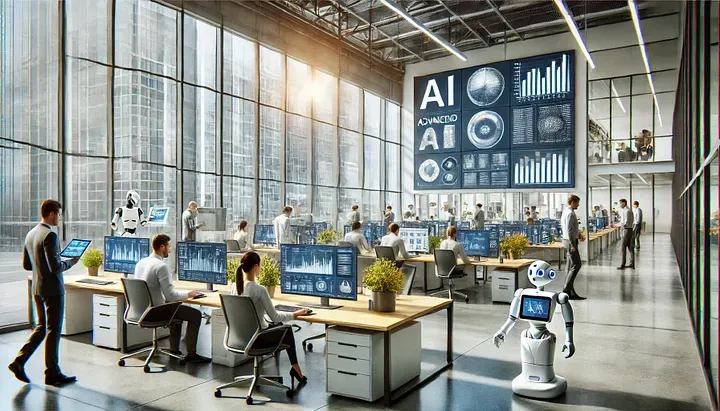Is AI Making Workers More Productive?

The rapid advancement of artificial intelligence has sparked considerable debate about its impact on productivity in the workplace. Some argue that AI is a powerful tool that enhances efficiency, reduces errors, and enables workers to focus on more creative and strategic tasks. Others contend that AI may not significantly improve productivity and, in some cases, might even hinder it by creating new challenges and complexities. This short essay will explore both sides of the argument to assess whether AI makes workers more productive.
AI has the potential to dramatically increase productivity by automating routine tasks, enabling better decision-making, and enhancing workers’ capabilities.
AI excels at handling repetitive, mundane tasks that consume a significant portion of employees’ time. AI systems can efficiently manage tasks such as data entry, scheduling, and even more complex processes like customer service queries. This automation allows workers to focus on higher-value activities requiring human creativity and problem-solving skills, theoretically increasing overall productivity.
AI systems can process vast amounts of data quickly and accurately, providing insights to improve decision-making. In finance, healthcare, and manufacturing industries, AI-powered analytics can identify trends, predict outcomes, and suggest optimal strategies. By augmenting human intelligence, AI helps workers make more informed decisions, which can lead to better outcomes and greater efficiency.
AI tools are increasingly integrated into collaborative platforms, streamlining communication and project management. For example, AI-driven project management tools can automatically allocate resources, track progress, and identify potential bottlenecks. This leads to smoother workflows, reduces delays, and enhances teams’ ability to work together effectively, ultimately boosting productivity.
AI enables more personalization in customer-facing roles, allowing workers to tailor their interactions to individual customer needs. This can lead to more satisfied customers, repeat business, and higher efficiency in sales and support roles. By offloading routine customer interactions to AI, workers can focus on more complex and rewarding aspects of customer engagement.
While AI has undeniable potential, its impact on productivity is not universally positive. Several challenges and limitations may hinder its ability to make workers more productive.
Implementing AI systems requires significant time and resources. Workers must be trained to use new tools effectively, and companies must invest in the necessary infrastructure. During the transition, productivity may decline as employees adapt to new workflows and processes. Furthermore, the integration of AI systems into existing operations can be complex and may disrupt established routines.
There is a risk that workers may become overly dependent on AI systems, leading to a decline in critical thinking and problem-solving skills. If AI tools are not properly calibrated or if they fail, workers who have become accustomed to relying on them may struggle to perform tasks independently, potentially leading to reduced productivity.
The rise of AI has led to concerns about job displacement, which can create anxiety among workers. This anxiety may manifest as resistance to adopting new technologies or a decreased morale, which can negatively impact productivity. Moreover, as AI takes over specific roles, workers may find themselves in jobs that do not fully utilize their skills, leading to disengagement and lower productivity.
AI systems can be complex to maintain and update. Over time, the cost and effort required to keep AI systems running smoothly can detract from their productivity benefits. Additionally, AI systems are not infallible; they can make mistakes, especially in areas requiring nuanced judgment. When errors occur, they may require significant human intervention, potentially reducing efficiency.
The impact of AI on worker productivity is multifaceted and context dependent. While AI has the potential to significantly enhance productivity by automating routine tasks, improving decision-making, and streamlining workflows, it also presents challenges such as the initial learning curve, the risk of over-reliance, job displacement anxiety, and the complexity of maintenance.
In environments where AI is effectively integrated and workers are supported through the transition, productivity gains can be substantial. However, in cases where AI is poorly implemented or the human-AI interaction is not well-managed, the expected productivity boost may not materialize, or worse, productivity may decline.
Ultimately, the extent to which AI makes workers more productive depends on how it is deployed, the nature of the tasks involved, and organizations’ ability to adapt to new technologies. A balanced approach that leverages AI’s strengths while addressing its limitations is key to realizing its full potential as a productivity-enhancing tool.
Join Us Towards a Greater Understanding of AI
By following us and sharing our content, you’re not just spreading awareness but also playing a crucial role in demystifying AI. Your insights, questions, and suggestions make this community vibrant and engaging. We’re eager to hear your thoughts on topics you’re curious about or wish to delve deeper into. Together, we can make AI accessible and engaging for everyone. Let’s continue this journey towards a better understanding of AI. Please share your thoughts with us via email: marty@bearnetai.com, and don’t forget to follow and share BearNetAI with others who might also benefit from it. Your support makes all the difference.
Thank you for being a part of this fascinating journey.
BearNetAI. From Bytes to Insights. AI Simplified.
Categories: Artificial Intelligence (AI), Technology and Innovation, Automation and Robotics, Business Management, Future of Work, Human-Computer Interaction, Economic Impact
The following sources are cited as references used in research for this BLOG post:
Superintelligence: Paths, Dangers, Strategies by Nick Bostrom
The Fourth Industrial Revolution by Klaus Schwab
Human + Machine: Reimagining Work in the Age of AI by Paul Daugherty and H. James Wilson
The Second Machine Age: Work, Progress, and Prosperity in a Time of Brilliant Technologies by Erik Brynjolfsson and Andrew McAfee
AI Superpowers: China, Silicon Valley, and the New World Order by Kai-Fu Lee
Rise of the Robots: Technology and the Threat of a Jobless Future by Martin Ford
Deep Medicine: How Artificial Intelligence Can Make Healthcare Human Again by Eric Topol
The Future of Work: Robots, AI, and Automation by Darrell M. West
Copyright 2024 BearNetAI LLC